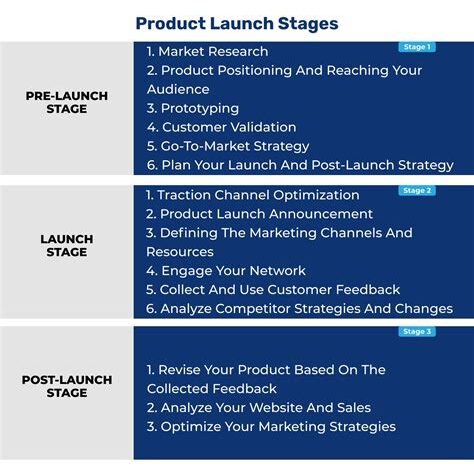How to Develop a Successful Product Launch Strategy

Learn how to conduct market research, identify your target audience, set clear objectives, create a unique selling proposition, and implement effective marketing channels for your business.Are you ready to launch a new product but unsure of how to effectively introduce it to the market? Developing a successful product launch strategy is crucial for reaching your target audience and maximizing your chances of success. In this blog post, we will explore the key components of a successful product launch strategy, including the importance of market research, identifying your target audience, setting clear objectives, creating a unique selling proposition, and implementing effective marketing channels. By understanding and applying these essential elements, you can ensure that your product launch captures the attention of potential customers and sets the stage for a successful introduction to the market. Whether you’re a new entrepreneur or an established business, these strategies will help you navigate the complexities of launching a new product and generate excitement and interest in what you have to offer. So, let’s dive in and explore the critical steps for developing a winning product launch strategy.
Market Research
In order to develop a successful product launch strategy, market research is a crucial first step. This involves gathering and analyzing information about the target market, including consumer preferences, buying behaviors, and market trends. By conducting thorough market research, companies can gain valuable insights that will help them understand the needs and desires of their potential customers.
Additionally, market research also involves competitive analysis, which allows businesses to identify their competitors and assess their strengths and weaknesses. Understanding the competitive landscape is essential for developing a product launch strategy that sets a brand apart from its rivals.
Moreover, market research helps businesses identify opportunities and challenges within the market, ultimately guiding them in making informed decisions about their product offerings and marketing approach. By leveraging the findings from market research, companies can tailor their strategies to effectively meet the demands of their target audience and maximize their chances of success.
Identifying Target Audience
When developing a successful product launch strategy, one of the key components is identifying the target audience. This involves understanding the demographics, psychographics, and behavior of the potential customers who are most likely to be interested in the product. Conducting thorough market research is essential in this process, as it helps in gaining insights into the target audience’s needs, preferences, and buying habits.
Furthermore, creating buyer personas can be an effective way to identify the target audience. By developing fictional representations of the ideal customers, businesses can gain a deeper understanding of their wants and needs, and tailor their marketing strategies accordingly. These personas can include details such as age, gender, income level, interests, and pain points, providing a clear picture of the target audience’s characteristics.
Utilizing data analytics and customer feedback can also be valuable in identifying the target audience. Monitoring website traffic, social media engagement, and sales trends can provide insights into the types of consumers who are most interested in the product. Additionally, gathering feedback through surveys, interviews, and reviews can offer valuable information about the target audience’s preferences and expectations.
Setting Clear Objectives
Setting clear objectives is a crucial step in developing a successful product launch strategy. It involves defining specific, measurable, achievable, relevant, and time-bound (SMART) goals that align with the overall business objectives. These objectives provide a clear direction for the product launch and help the team stay focused on the desired outcomes.
It is important to involve key stakeholders in the process of setting clear objectives to ensure alignment and buy-in from all parties. This collaborative approach helps in gaining different perspectives and insights, ultimately leading to more comprehensive and realistic objectives that consider various aspects of the product launch.
Furthermore, setting clear objectives also involves establishing key performance indicators (KPIs) to track the progress and success of the product launch. These KPIs serve as benchmarks for evaluating the performance of the launch strategy and help in making informed decisions to optimize the results.
Creating a Unique Selling Proposition
How to Develop a Successful Product Launch Strategy
When it comes to launching a new product, having a unique selling proposition (USP) is essential. Your USP is what sets your product apart from the rest of the market. It’s what makes your product different and why customers should choose it over competitors. In order to create a successful USP, you need to thoroughly research the market and understand the needs and desires of your target audience. This will allow you to tailor your USP to meet those specific needs.
Once you have identified your target audience and their needs, you can then begin to craft your USP. Your USP should clearly communicate the benefits of your product and why it is the best choice for your target audience. It should be concise and easy to understand, yet powerful enough to make a lasting impression on potential customers. A strong USP can make all the difference in the success of your product launch.
After you have developed your USP, it’s important to ensure that it is effectively communicated through all of your marketing channels. Your USP should be prominently featured in your product messaging, advertising, and promotional materials. Consistency is key when it comes to reinforcing your USP and building brand recognition. By effectively communicating your USP, you can attract the attention of your target audience and compel them to choose your product over others in the market.
Implementing Effective Marketing Channels
When it comes to successfully launching a product, one of the most crucial steps is implementing effective marketing channels. This means identifying the best platforms and mediums to reach your target audience and communicate the value of your product. Whether it’s through social media, email marketing, content marketing, or traditional advertising, choosing the right marketing channels can make all the difference in the success of your product launch.
Implementing effective marketing channels also involves understanding the behaviors and preferences of your target audience. By knowing where your audience spends their time online, what type of content they engage with, and how they prefer to receive information, you can tailor your marketing efforts to meet their needs and interests.
Furthermore, it’s important to continuously track and measure the performance of your marketing channels. By analyzing the data and insights from each channel, you can make informed decisions about where to allocate your resources and optimize your strategies for maximum impact.





